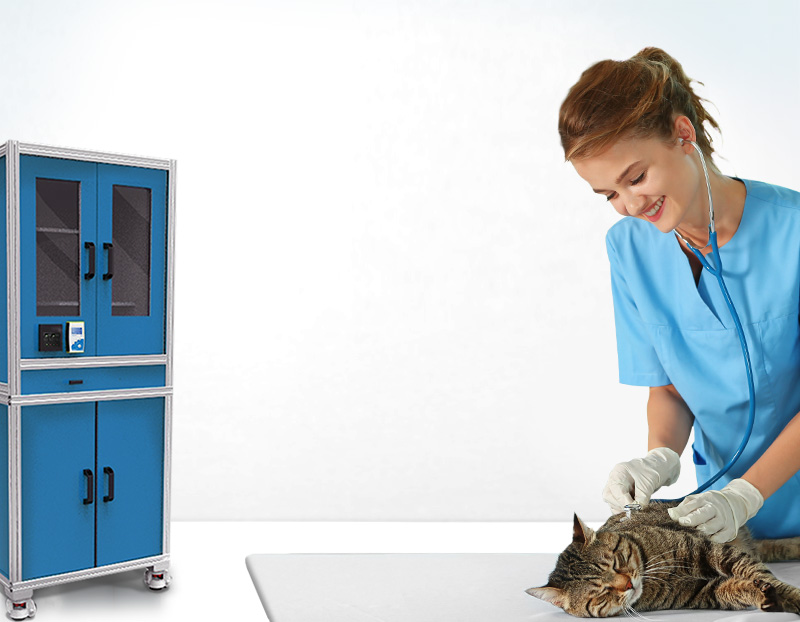
Hyperthyroidism is the most common endocrinopathy of domestic cats. It is usually the result of thyroid adenoma(s) or multiple hyperplasic nodules which may be unilateral or bilateral. Not all nodules are palpable. Functional thyroid tissue may elaborate increased amounts of thyroxine (T4) and T3, producing clinical signs including (i) a loud and fast heart, (ii) a prominent precordial impulse, (iii) a strong pulse and (iv) weight loss with good appetite. Heat intolerance, behavioural changes and polydipsia/polyuria can also be evident. Left untreated, hyperthyroidism damages a variety of end organs, particularly the heart and kidneys. The resulting catabolic state likely foreshortens life expectancy.
Hyperthyroidism is the most common endocrinopathy of domestic cats. It is usually the result of thyroid adenoma(s) or multiple hyperplasic nodules which may be unilateral or bilateral. Not all nodules are palpable. Functional thyroid tissue may elaborate increased amounts of thyroxine (T4) and T3, producing clinical signs including (i) a loud and fast heart, (ii) a prominent precordial impulse, (iii) a strong pulse and (iv) weight loss with good appetite. Heat intolerance, behavioural changes and polydipsia/polyuria can also be evident. Left untreated, hyperthyroidism damages a variety of end organs, particularly the heart and kidneys. The resulting catabolic state likely foreshortens life expectancy. Hyperparathyroidism is reported to be rare in geriatric cats but, in my opinion, it is likely under-diagnosed. A functional parathyroid tumour secretes parathyroid hormone (PTH), causing hypercalcaemia, which results in azotaemia, polyuria, incessant polydipsia, sporadic vomiting, twitching and reduced appetite. These signs also occur with chronic renal insufficiency which can confuse the issue, as many elderly cats have some degree of kidney dysfunction. To confuse matters further, some cats have concurrent thyroid and parathyroid lesions. Experienced veterinarians with sensitive palpation skills can detect ventral cervical nodule(s) in many old cats – some are thyroid in origin, others are parathyroid. Some are functional; some are non-functional or ‘pre-functional’. Indeed, the presence of an incidental mass in the cervical/(para) thyroid area is an enigma in feline medicine because the only unequivocal way to distinguish thyroid from parathyroid masses is excisional biopsy.
Hyperthyroidism is the most common endocrinopathy of domestic cats. It is usually the result of thyroid adenoma(s) or multiple hyperplasic nodules which may be unilateral or bilateral. Not all nodules are palpable. Functional thyroid tissue may elaborate increased amounts of thyroxine (T4) and T3, producing clinical signs including (i) a loud and fast heart, (ii) a prominent precordial impulse, (iii) a strong pulse and (iv) weight loss with good appetite. Heat intolerance, behavioural changes and polydipsia/polyuria can also be evident. Left untreated, hyperthyroidism damages a variety of end organs, particularly the heart and kidneys. The resulting catabolic state likely foreshortens life expectancy. Hyperparathyroidism is reported to be rare in geriatric cats but, in my opinion, it is likely under-diagnosed. A functional parathyroid tumour secretes parathyroid hormone (PTH), causing hypercalcaemia, which results in azotaemia, polyuria, incessant polydipsia, sporadic vomiting, twitching and reduced appetite. These signs also occur with chronic renal insufficiency which can confuse the issue, as many elderly cats have some degree of kidney dysfunction. To confuse matters further, some cats have concurrent thyroid and parathyroid lesions. Experienced veterinarians with sensitive palpation skills can detect ventral cervical nodule(s) in many old cats – some are thyroid in origin, others are parathyroid. Some are functional; some are non-functional or ‘pre-functional’. Indeed, the presence of an incidental mass in the cervical/(para) thyroid area is an enigma in feline medicine because the only unequivocal way to distinguish thyroid from parathyroid masses is excisional biopsy.
Hyperthyroidism is the most common endocrinopathy of domestic cats. It is usually the result of thyroid adenoma(s) or multiple hyperplasic nodules which may be unilateral or bilateral. Not all nodules are palpable. Functional thyroid tissue may elaborate increased amounts of thyroxine (T4) and T3, producing clinical signs including (i) a loud and fast heart, (ii) a prominent precordial impulse, (iii) a strong pulse and (iv) weight loss with good appetite. Heat intolerance, behavioural changes and polydipsia/polyuria can also be evident. Left untreated, hyperthyroidism damages a variety of end organs, particularly the heart and kidneys. The resulting catabolic state likely foreshortens life expectancy. Hyperparathyroidism is reported to be rare in geriatric cats but, in my opinion, it is likely under-diagnosed. A functional parathyroid tumour secretes parathyroid hormone (PTH), causing hypercalcaemia, which results in azotaemia, polyuria, incessant polydipsia, sporadic vomiting, twitching and reduced appetite. These signs also occur with chronic renal insufficiency which can confuse the issue, as many elderly cats have some degree of kidney dysfunction. To confuse matters further, some cats have concurrent thyroid and parathyroid lesions. Experienced veterinarians with sensitive palpation skills can detect ventral cervical nodule(s) in many old cats – some are thyroid in origin, others are parathyroid. Some are functional; some are non-functional or ‘pre-functional’. Indeed, the presence of an incidental mass in the cervical/(para) thyroid area is an enigma in feline medicine because the only unequivocal way to distinguish thyroid from parathyroid masses is excisional biopsy.
